 Oases
Oases
APPROACHING THE 80TH ANNIVERSARY OF THE BELGRADE CORNER FOR ANIMALS AND PEOPLE WHO LOVE THEM
The Garden of Good Hope
Founded on St. Peter’s Day in 1936, the Belgrade Zoo has shared the destiny of its city. It, therefore, has had an exciting history, not for the weak. It had fewer directors than the number of countries it has changed and political orders. It has had its big and small heroes, unusual donors, events that have entered literature, film, popular culture. History of Belgrade has better memory of chimpanzee Sami, female dog Gabi, alligator Muja, elephants Tisa and Mita, little ninja bears, then of some immature prime ministers and ministers
By: Miloš Lazić
Photo: Želјko Sinobad
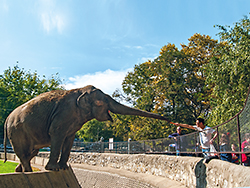 Those who did not visit the Garden of Good Hope, the Belgrade Zoo, came here in vain; as if they were not in the capital at all. Indeed, the indifferent statistics warns that it is the most visited city destination: by the number of guests it is superior even to sporting events or spectacular music concerts, while the capital’s museums and galleries can only daydream and sigh over this information. It has been like this for 79 years already, and it will be the same also next year, on St. Peter’s Day, July 12 w
Those who did not visit the Garden of Good Hope, the Belgrade Zoo, came here in vain; as if they were not in the capital at all. Indeed, the indifferent statistics warns that it is the most visited city destination: by the number of guests it is superior even to sporting events or spectacular music concerts, while the capital’s museums and galleries can only daydream and sigh over this information. It has been like this for 79 years already, and it will be the same also next year, on St. Peter’s Day, July 12 w hen, God willing, it will celebrate eight decades of the existence of this oasis of life.
hen, God willing, it will celebrate eight decades of the existence of this oasis of life.
Although many Belgraders believe that they know the soul of their Garden of Good Hope, that it is ”a book read long ago”, this is not quite true. Because, the outskirts of Belgrade Fortress, the desigen dpaths between the cages, are inhabited by luring mysteries, while jealously guarded secrets wait in the corners. Well, let us uncover them, bring at least some of them to to the light of the day.
PEOPLE WITH WIDE HORIZONS
 At one time, Vukosav Bojović planned to mount next at the entrance to the Garden of Good Hope, near the bronze bust of Vlada Ilić, president of the Belgrade municipality and the founder of this ”Park of Life”, two marble plaques with inscribed names of all noble people who had helped with their gifts the building of this Garden, helped populating it and helped it survive and stay what it is today. Although, these marble plaques with names of the donors should be much more, they would run out of free walls! That is why we should mention at least three biggest ones.
At one time, Vukosav Bojović planned to mount next at the entrance to the Garden of Good Hope, near the bronze bust of Vlada Ilić, president of the Belgrade municipality and the founder of this ”Park of Life”, two marble plaques with inscribed names of all noble people who had helped with their gifts the building of this Garden, helped populating it and helped it survive and stay what it is today. Although, these marble plaques with names of the donors should be much more, they would run out of free walls! That is why we should mention at least three biggest ones.
 The first among them is Vlada Ilić, mayor and a manufacturer who, during the establishment of the Zoo, did not put his hand in the state treasury but in his own pocket. We are warned about this by his bronze monument and alligator Muja who is, at the age of 79, the oldest tenant and the contemporary of this oasis. Professor Aleksandar Krstić, the first director of the Garden, tried to compete with him. In 1937 he bought hippo Buca and donated it to the children of Belgrade, and to celebrate the birth of his son Mirko.
The first among them is Vlada Ilić, mayor and a manufacturer who, during the establishment of the Zoo, did not put his hand in the state treasury but in his own pocket. We are warned about this by his bronze monument and alligator Muja who is, at the age of 79, the oldest tenant and the contemporary of this oasis. Professor Aleksandar Krstić, the first director of the Garden, tried to compete with him. In 1937 he bought hippo Buca and donated it to the children of Belgrade, and to celebrate the birth of his son Mirko.
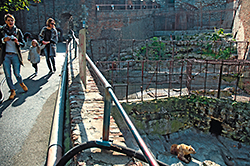 The second one of the three great people of the Garden is (although this will sound incredible!) Josip Broz Tito! Although the protocol and various security services were hiding this quite successfully, the information leaked that he often took on his trips on ”Galeb” the directors of Belgrade and Zagreb Zoos, that the ship would sail there as a passenger yacht, and was returning from there as Noah’s Arc. The first tigers that arrived to Belgrade from Sri Lanka, from the Light Island, were presented to local citizens as gifts from Solomon and Sirimavo Bandaranaike to the children of Yugoslavia, and they were actually the gift to the respected guest, the leader of the Non-Alignment Movement. The first rhinos, which was officially donated by the government of Zimbabwe, and unofficially were gift from president Roberta Mugabe to Tito, did not disembark in Brioni, but at the Sava Harbor in Belgrade. Six camels from Libya, accompanied by Colonel
The second one of the three great people of the Garden is (although this will sound incredible!) Josip Broz Tito! Although the protocol and various security services were hiding this quite successfully, the information leaked that he often took on his trips on ”Galeb” the directors of Belgrade and Zagreb Zoos, that the ship would sail there as a passenger yacht, and was returning from there as Noah’s Arc. The first tigers that arrived to Belgrade from Sri Lanka, from the Light Island, were presented to local citizens as gifts from Solomon and Sirimavo Bandaranaike to the children of Yugoslavia, and they were actually the gift to the respected guest, the leader of the Non-Alignment Movement. The first rhinos, which was officially donated by the government of Zimbabwe, and unofficially were gift from president Roberta Mugabe to Tito, did not disembark in Brioni, but at the Sava Harbor in Belgrade. Six camels from Libya, accompanied by Colonel 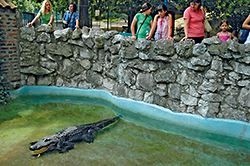 Muammar Gaddafi (our fellow), also disembarked on the Sava. Many other animals also arrived in the capital city of Serbia thanks to Broz’s reputation, or his discrete help.
Muammar Gaddafi (our fellow), also disembarked on the Sava. Many other animals also arrived in the capital city of Serbia thanks to Broz’s reputation, or his discrete help.
The third giant of the Zoo is Nićifor Nik Aničić, from Jadovnik, today exceptionally successful businessman in South Africa, who donated to the children of Belgrade everything white: white lions, white tigers, white meerkats, white kangaroos, white antelopes... For its benefactions and the place of living, the Zoo entered the city codebook as – the Garden of Good Hope.
It is controversial information that today Vlada Ilić and Nik Aničić have their alleys in the Garden of Good Hope, while only Josip Broz does not have the ”blue board”.
ETHICS OF SUSPICIOUS LORDS
 When in 1953, Winston Churchill was pronounced the Knight of the Garter and gained the right to present himself as a lord, he received an equally important recognition: he became a laureate of the Nobel Prize for literature (”for his skill in presenting historical and bibliographic descriptions, and brilliant oratory skill that he used in defense of high human values”, it was written in the explanation). Besides, he was awarded for his six-volume memoir thriller which he simply entitled – World War Two.
When in 1953, Winston Churchill was pronounced the Knight of the Garter and gained the right to present himself as a lord, he received an equally important recognition: he became a laureate of the Nobel Prize for literature (”for his skill in presenting historical and bibliographic descriptions, and brilliant oratory skill that he used in defense of high human values”, it was written in the explanation). Besides, he was awarded for his six-volume memoir thriller which he simply entitled – World War Two.
Three decades had to pass until someone idle realized that in this capital work of his Churchill dedicated only one paragraph to Yugoslavia. And not just an ordinary paragraph, but full three sentences in which he described the bombing of Belgrade on April 6 and the animals from the demolished Belgrade Zoo running frantically around the city. And the people?
If he had only made an effort, he would have learned about the tragic destiny of Miodrag Savković, the ”war director” of the Zoo, who was immediately after the liberation arrested and executed without a trial for ”collaborating with the occupier”, although during this period the garden was closed because it was, with equal enthusiasm, bombed by both the Germans and the Allies, with enviable precision. Especially the latter,  when the bombers would come back after unfinished job from Romania, from oil fields around Ploiesti, pa and would drop their deadly cargo where they felt like it, and most often on Belgrade, although other inhabited places in Serbia were not spared of such outpours of Allies’ assistances.
when the bombers would come back after unfinished job from Romania, from oil fields around Ploiesti, pa and would drop their deadly cargo where they felt like it, and most often on Belgrade, although other inhabited places in Serbia were not spared of such outpours of Allies’ assistances.
There is a story that the ill-fortuned Savković fell on the ”fender of the Garden”, because he opposed the decision of the National Liberation front of the First Region (Dorćol) to give the ”Kalemegdan Terrace” which had been working until the war as a café of the Zoo (which is still testified by a closed passage behind the cage with big cats that led upstairs), to some newly found hospitality establishment. The said company later expanded to the inner part as well, in the place that, until 1933 and the construction of memorial charnel house on the New Cemetery, housed the remains of the liberators of Belgrade from the beginning of the Great War, who died there.
The tragic fate of Miodrag Savković was a cruel warning, so that the later occupation by the offices of the ”City Greenery” of the area of the Zoo, the part that had been designed by professor Krstić as the director’s apartment, was carried out with no opposition. Some offices of the ”Greenery” are still there today, they wouldn’t even blush for this usurpation.
HEROES, UNFORGETTABLE AND FORGOTTEN
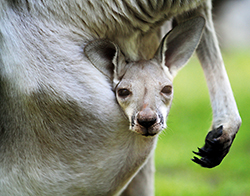 There are three heroes mentioned the official website of Belgrade Zoo. These are Sami, Gabi and Muja. Sami was a chimpanzee, Alfa-male, who ventured into the city twice, to have an adventure, thus inadvertently causing the first post-war free demonstrations of jolly and curious people.
There are three heroes mentioned the official website of Belgrade Zoo. These are Sami, Gabi and Muja. Sami was a chimpanzee, Alfa-male, who ventured into the city twice, to have an adventure, thus inadvertently causing the first post-war free demonstrations of jolly and curious people.
Gabi was a long-haired German shepherd that boldly ventured into the battle with much bigger and stronger runaway female jaguar, rescuing even the Zoo night guard and who knows how many passers-by that would have been attacked by the angered beast. For this, Gabi was given a bronze monument during her lifetime, in front of the administration building, and well-deserved ”disability pension”, which she chewed on until the end.
 Muja is an American alligator and, as they believe, the oldest living specimen of his species in the world.
Muja is an American alligator and, as they believe, the oldest living specimen of his species in the world.
But, Tisa and Mita, the elephants that inspired respect of the visitors of all ages with the strength they carried with philosophical peace have been forgotten. And where is Sonja, the small rhesus monkey, who was bringing joy in the days of youth of those who are today middle-aged? Or her namesake, an orangutan, who did not hide that she was head over heels in love with Vuk Bojović? And  bear Nidža? And what happened with those two bear cubs that the wind of war separated them from their mother somewhere on Velebit, and Belgrade jokers called them ”Ninjas”?
bear Nidža? And what happened with those two bear cubs that the wind of war separated them from their mother somewhere on Velebit, and Belgrade jokers called them ”Ninjas”?
All eight directors should also be included among the heroes of the Garden of Good hope, from Aleksandar Krstić and the ill-fortuned Miodrag Savković, through Ante Tadić, Milorad Lazarević, Milorad Medenica, Radivoje Tričković and Vukosav Bojović, to the last one, Gvozden Radenković. If nothing else the because, when all is added up, there were fewer of them than the states or regimes that the Garden has survived.
***
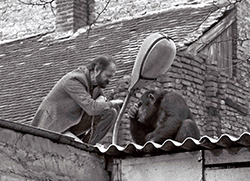 Sami
Sami
When he first ran away into the city, Chimp Sami caused panic, but his second excursion was followed by signs ”Hold on, Sami”, ”We are with you” and ”Freedom or Dearth”, and the confused law enforcement officers did not know how to react. The problem was solved by the legendary director Vuk Bojović, who managed to talk him into coming back home both times.
***
The unrealized relocation
It is les known that 1990 very serious negotiations were held to relocate the Broz’s Zoo from Brioni to Belgrade, for some insignificant sum of money, but this idea was hindered by the cessation of payment operations between the two Yugoslav republics, as an introduction into the disintegration of the country. People from our country did not want to pay for animals in advance, without seeing them first, and the neighbors did not want to send them under such conditions for the same reason.
